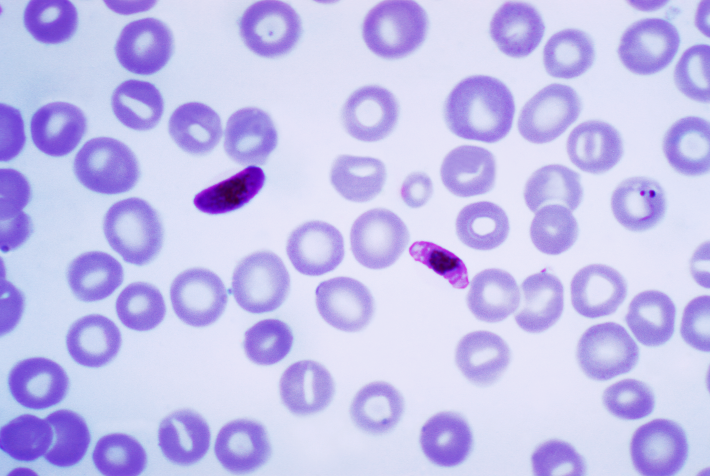by Piter Kehoma Boll
Humans can be infected by a vast number of different parasites, but no parasite has such a big impact on our species as those of the genus Plasmodium, which cause the disease called malaria. Several different species of Plasmodium infect humans, but today we will talk about the deadliest of them, Plasmodium falciparum, which I decided to name the Deadly Plasmodium.
The genus Plasmodium belongs to the phylum Apicomplexa, a group of exclusively parasitic protists that evolved from free-living algae. Besides Plasmodium, another important apicomplexan that infects humans is the Toxo, which causes toxoplasmosis and already appeared as a fellow here some years ago.
The life cycle of the deadly plasmodium is very complex and includes two hosts, a human and a mosquito of the genus Anopheles. When an infected mosquito bites a human, it releases between 20 and 200 sporozoites, which are one of the life stages of the deadly plasmodium. The sporozoites are elongated cells that glide through the bloodstream of the infected human until they reach the liver. They use their apical complex, a structure formed by several glands and organelles, to penetrate the liver cells. The apical complex is lost in the process.

Inside the liver cells, the sporozoite changes into a trophozoite, which lives inside a vacuole and starts to grow and undergo mitosis and meiosis without cell division until becoming a single cell with tens of hundreds of nuclei called a schizont. The schizont eventually bursts into tens of thousands of small haploid cells called merozoites, which enter the bloodstream again. Provided with new apical complexes, the merozoites now use it to enter red blood cells and turn again into trophozoites, which are now haploid. This haploid red-cell-infecting trophozoite grows again and undergoes mitosis to make a new large schizont, which eventually bursts again into new merozoites that enter the bloodstream once more and infect new red cells, starting the cycle again. Inside the red cells, the trophozoite feeds on hemoglobin and converts part of it into an insoluble granular pigment called hemozoin.

All plasmodium cells infecting the red blood cells have their cycle in synchrony so that all merozoites are released into the bloodstream and infect new cells simultaneously. The cycle in the red blood cells takes about 48 hours and is related to the typical cyclic manifestations of fever and chills caused by falciparum malaria.
Eventually, some merozoites change into sexual forms, the male and female gametocytes, known as microgametocyte and macrogametocyte, respectively. They take between one and two weeks to reach maturity. After reaching this stage, if the infected human is bitten by a mosquito, the gametocytes are ingested and, inside the mosquito’s gut, undergo morphological changes. The macrogametocytes grow into a large, spherical form, the macrogamete. The microgametocyte undergoes nuclear division in 15 minutes and splits into eight flagellated microgametes. A microgamete fertilizes a macrogamete, which originates a zygote. The zygote develops into a motile cell called the ookinete, which penetrates the mosquito tissues and turns into an immotile oocyst. The oocyst grows and undergoes nuclear division until becoming a large multinucleate cell called sporoblast. The sporoblast bursts into thousands of sporozoites, which migrate to the mosquito’s salivary glands and, when the mosquito bites another human, they are released into the bloodstream and restart the cycle.

The main deleterious effects caused by malaria in humans occur due to the massive destruction of red blood cells and the production of hemozoin, which is toxic to tissue and starts to accumulate in several organs, impairing their function. Although several species of Plasmodium can cause malaria in humans, about 50% of all deaths by malaria are caused by the deadly plasmodium alone, making it the deadliest parasite in humans.
The deadly plasmodium apparently evolved about 10 thousand years ago in Africa from a very similar species that infects gorillas. Currently, although most infections and deaths still occur in Subsaharan Africa, the deadly plasmodium has spread around the world and is also prevalent in regions near the equator in South America and Asia.
Due to the high lethality of falciparum malaria in humans, the disease has placed great selective pressure on human populations in areas where this parasite is common. Thus, although some say that natural selection does not affect humans anymore, the deadly plasmodium is here to refute this argument.
– – –
Other Apicomplexans:
Friday Fellow: Toxo (on 5 May 2017)
Friday Fellow: Arrow Anchor (on 15 January 2021)
– – –
– – –
References:
Lambros, C., & Vanderberg, J. P. (1979). Synchronization of Plasmodium falciparum erythrocytic stages in culture. The Journal of parasitology, 418-420.
Maier, A. G., Matuschewski, K., Zhang, M., & Rug, M. (2019). Plasmodium falciparum. Trends in parasitology, 35(6), 481-482. https://doi.org/10.1016/j.pt.2018.11.010
Talman, A. M., Domarle, O., McKenzie, F. E., Ariey, F., & Robert, V. (2004). Gametocytogenesis: the puberty of Plasmodium falciparum. Malaria journal, 3(1), 1-14. https://doi.org/10.1186/1475-2875-3-24
Wikipedia. Plasmodium falciparum. Available at < https://en.wikipedia.org/wiki/Plasmodium_falciparum >.
– – –
** This work is licensed under a Creative Commons Attribution 3.0 Unported License.
This work is licensed under a Creative Commons Attribution 3.0 Unported License.
